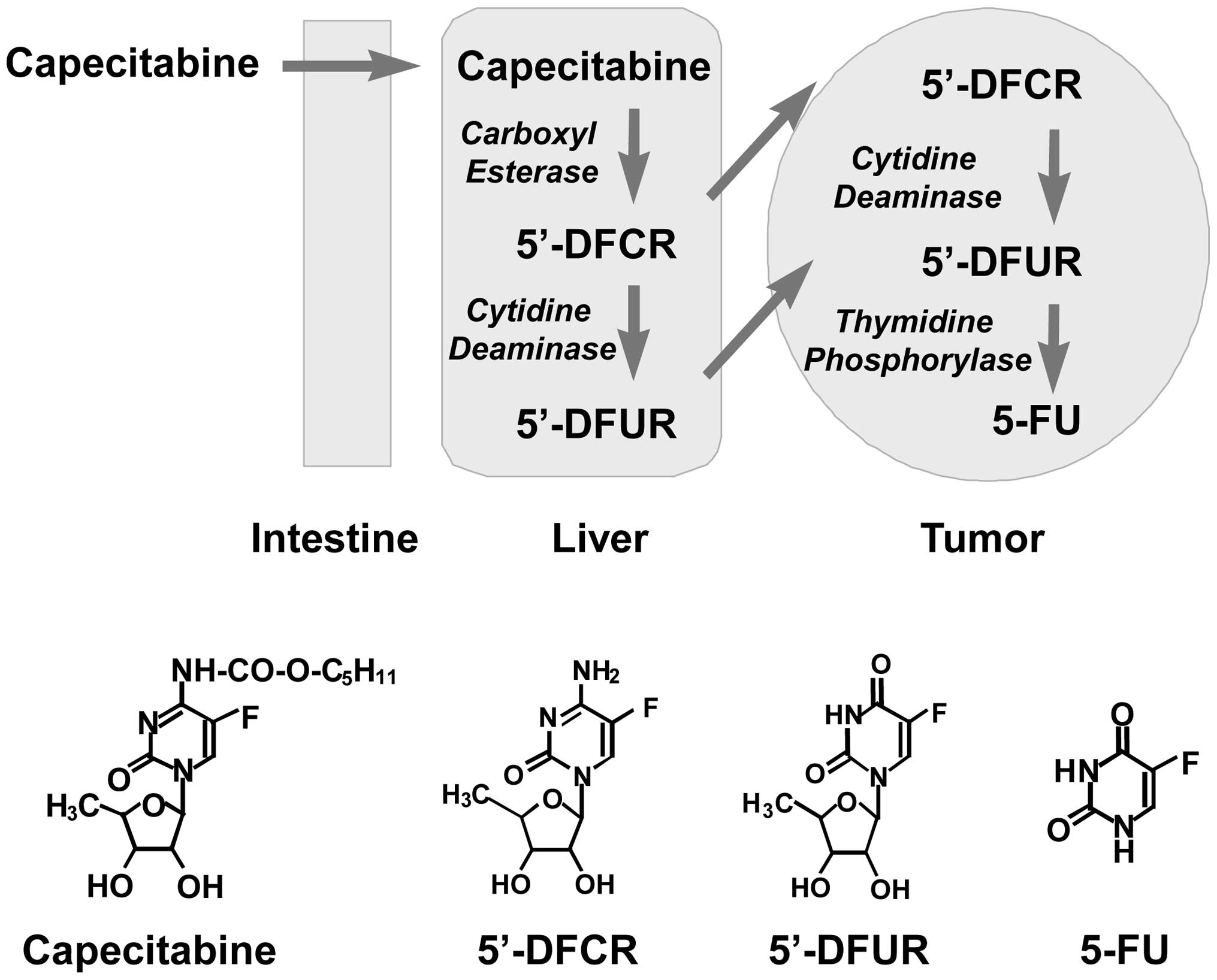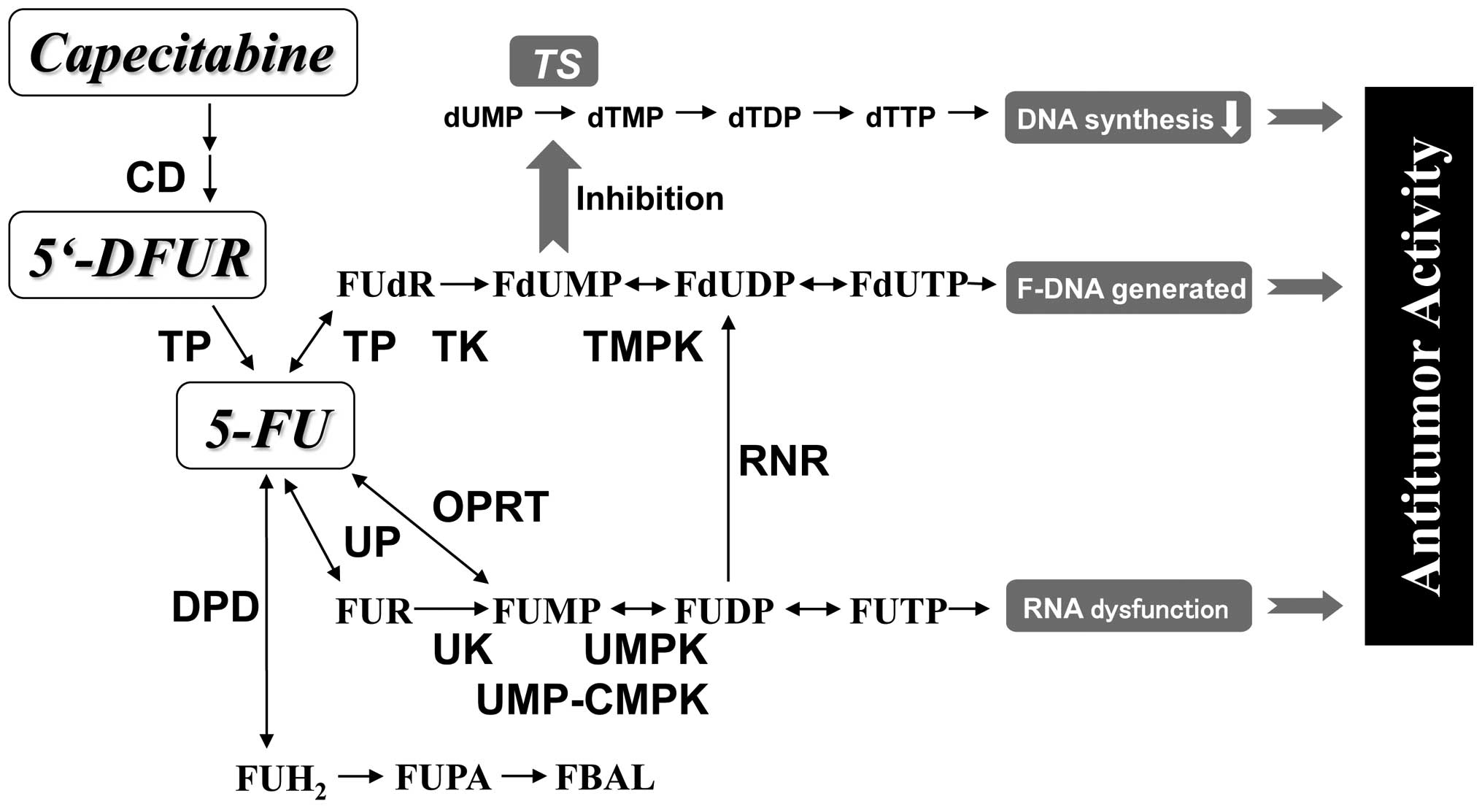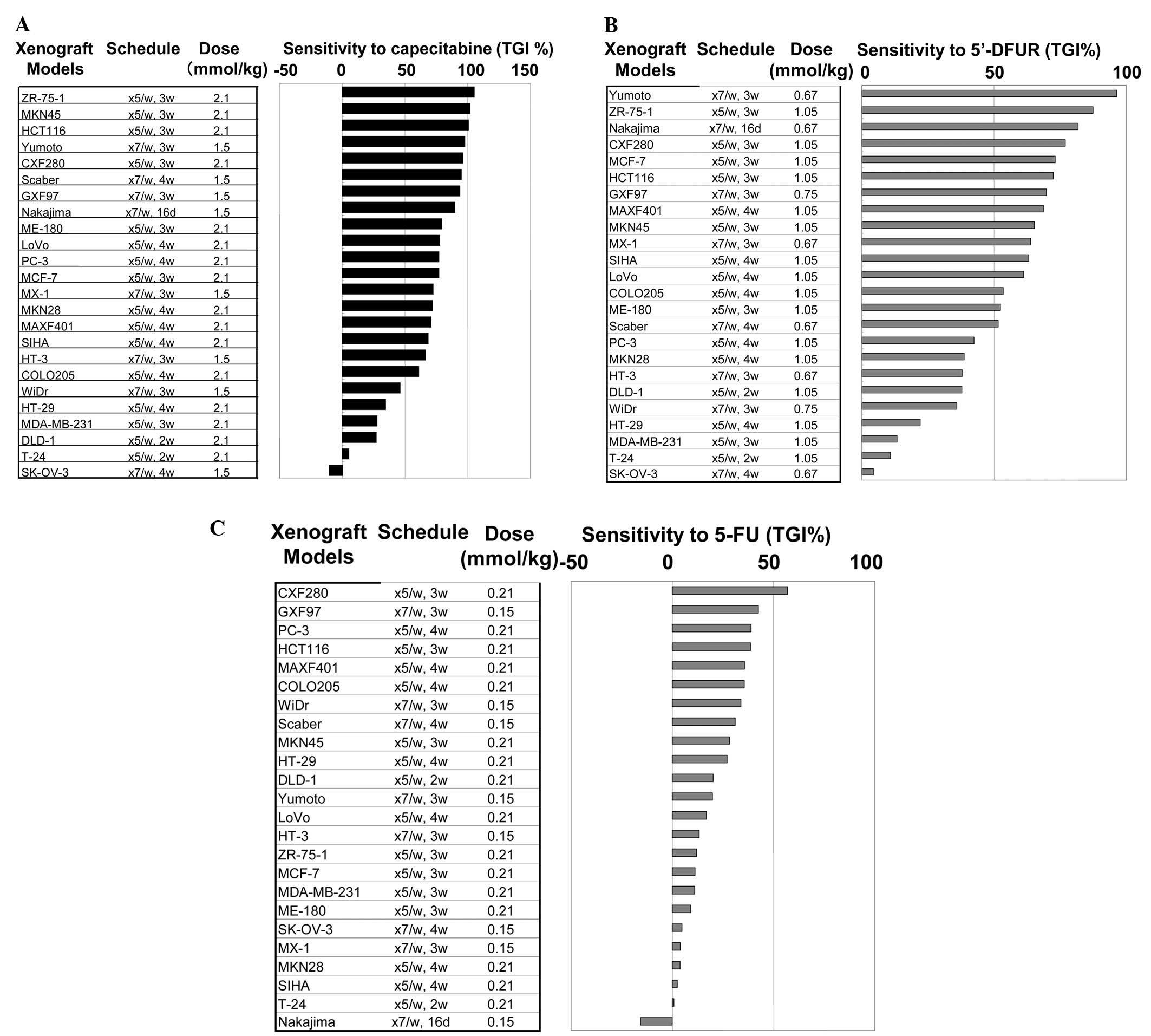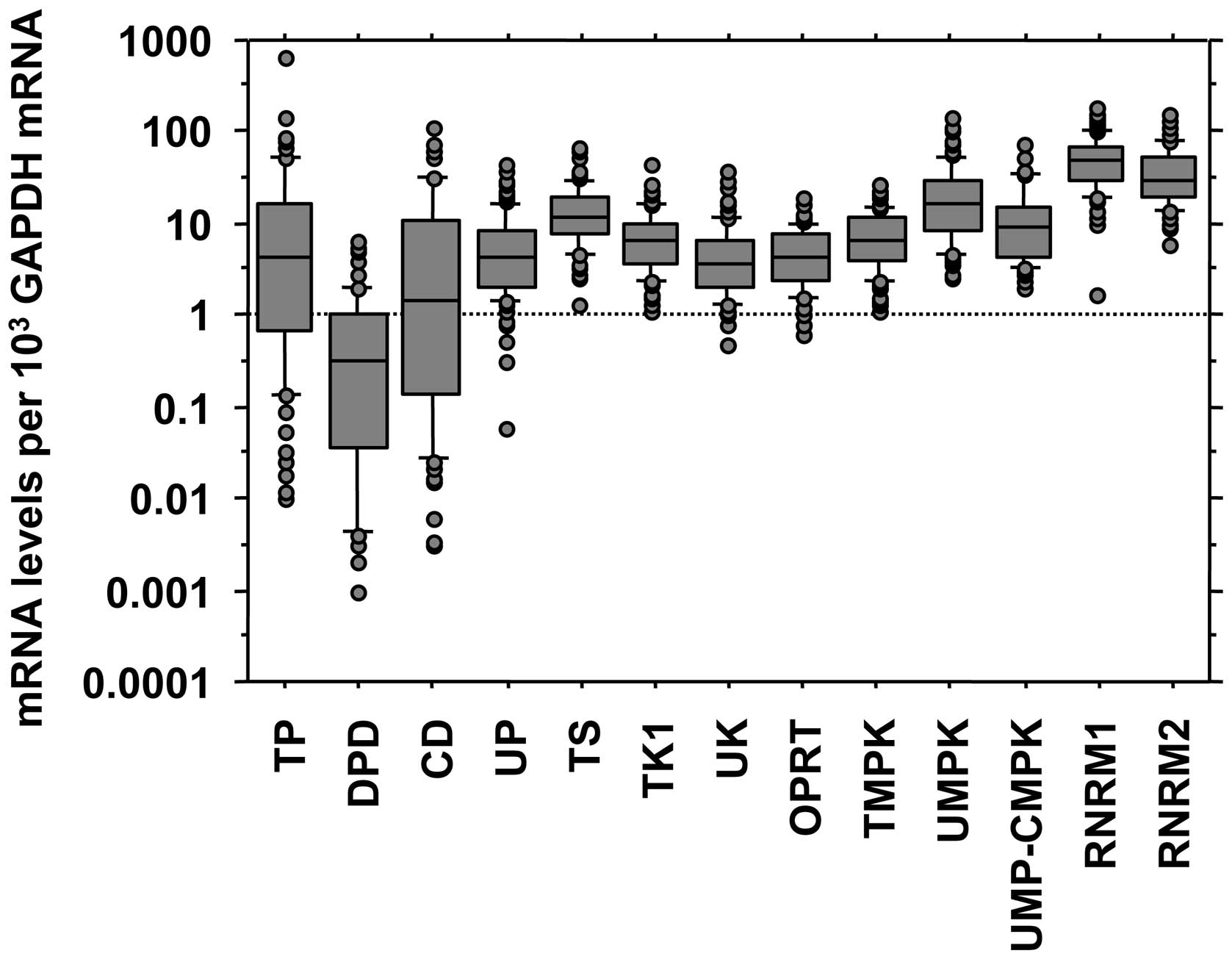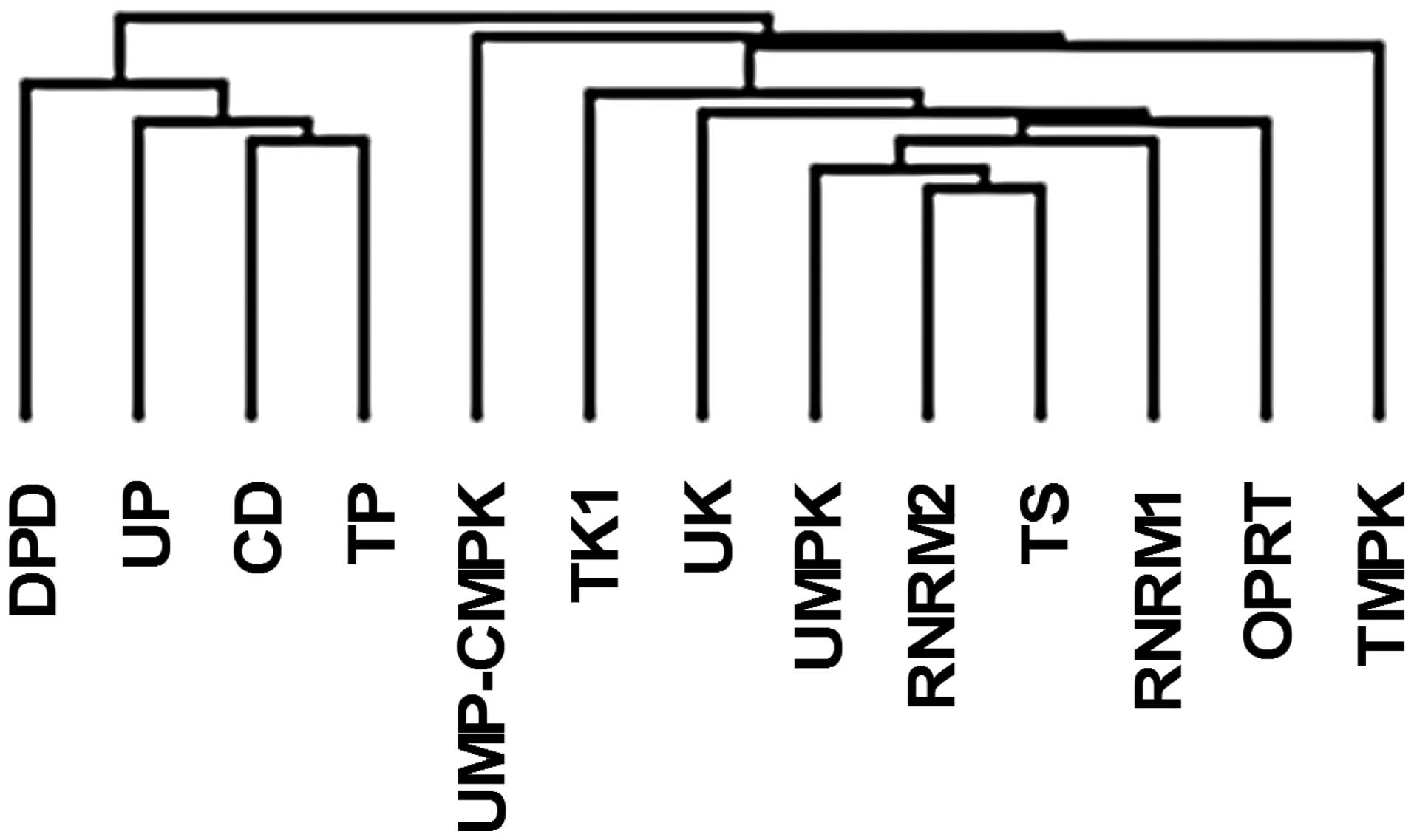|
1
|
Miwa M, Ura M, Nishida M, Sawada N,
Ishikawa T, Mori K, Shimma N, Umeda I and Ishitsuka H: Design of a
novel oral fluoropyrimidine carbamate, capecitabine, which
generates 5-fluorouracil selectively in tumours by enzymes
concentrated in human liver and cancer tissue. Eur J Cancer.
34:1274–1281. 1998. View Article : Google Scholar
|
|
2
|
Ishikawa T, Utoh M, Sawada N, Nishida M,
Fukase Y, Sekiguchi F and Ishitsuka H: Tumor selective delivery of
5-fluorouracil by capecitabine, a new oral fluoropyrimidine
carbamate, in human cancer xenografts. Biochem Pharmacol.
55:1091–1097. 1998. View Article : Google Scholar : PubMed/NCBI
|
|
3
|
Schuller J, Cassidy J, Dumont E, Roos B,
Durston S, Banken L, Utoh M, Mori K, Weidekamm E and Reigner B:
Preferential activation of capecitabine in tumors following oral
administration to colorectal cancer patients. Cancer Chemother
Pharmacol. 45:291–297. 2000. View Article : Google Scholar : PubMed/NCBI
|
|
4
|
Pentheroudakis G and Twelves C: The
rational development of capecitabine from the laboratory to the
clinic. Anticancer Res. 22:3589–3596. 2002.PubMed/NCBI
|
|
5
|
Ishikawa T, Sekiguchi F, Fukase Y, Sawada
N and Ishitsuka H: Positive correlation between the efficacy of
capecitabine and doxifluridine and the ratio of thymidine
phosphorylase to dihydropyrimidine dehydrogenase activities in
tumors in human cancer xenografts. Cancer Res. 58:685–690.
1998.
|
|
6
|
Aschele C, Sobrero A, Faderan MA and
Bertino JR: Novel mechanism(s) of resistance to 5-fluorouracil in
human colon cancer (HCT-8) sublines following exposure to two
different clinically relevant dose schedules. Cancer Res.
52:1855–1864. 1992.
|
|
7
|
Aschele C, Lonardi S and Monfardini S:
Thymidylate synthase expression as a predictor of clinical response
to fluoropyrimidine-based chemotherapy in advanced colorectal
cancer. Cancer Treat Rev. 28:27–47. 2002. View Article : Google Scholar : PubMed/NCBI
|
|
8
|
Kubota T, Watanabe M, Otani Y, Kitajima M
and Fukushiuma M: Different pathways of 5-fluorouracil metabolism
after continuous venous or bolus injection in patients with colon
carcinoma: possible predictive value of thymidylate synthetase mRNA
and ribonucleotide reductase for 5-fluorouracil sensitivity.
Anticancer Res. 22:3537–3540. 2002.
|
|
9
|
Sawada N, Ishikawa T, Fukase Y, Nishida M,
Yoshikubo T and Ishitsuka H: Induction of thymidine phosphorylase
activity and enhancement of capecitabine efficacy by taxol/taxotere
in human cancer xenografts. Clin Cancer Res. 4:1013–1019.
1998.PubMed/NCBI
|
|
10
|
Endo M, Shinbori N, Fukase Y, Sawada N,
Ishikawa T, Ishitsuka H and Tanaka Y: Induction of thymidine
phosphorylase expression and enhancement of efficacy of
capecitabine or 5′-deoxy-5-fluorouridine by cyclophosphamide in
mammary tumor models. Int J Cancer. 83:127–134. 1999.
|
|
11
|
Sawada N, Ishikawa T, Sekiguchi F, Tanaka
Y and Ishitsuka H: X-ray irradiation induces thymidine
phosphorylase and enhances the efficacy of capecitabine (Xeloda) in
human cancer xenografts. Clin Cancer Res. 5:2948–2953.
1999.PubMed/NCBI
|
|
12
|
Kurosumi M, Tabei T, Suemasu K, Inoue K,
Kusawake T, Sugamata N and Higashi Y: Enhancement of
immunohistochemical reactivity for thymidine phosphorylase in
breast carcinoma cells after administration of docetaxel as a
neoadjuvant chemotherapy in advanced breast cancer patients. Oncol
Rep. 7:945–948. 2000.
|
|
13
|
Toi M and Ohno S: The role of thymidine
phosphorylase (TP) in choosing FU/capecitabine chemotherapy. Proc
Am Soc Clin Oncol. 22:1372003.
|
|
14
|
O’Shaughnessy J, Miles D, Vukelja S,
Moiseyenko V, Ayoub JP, Cervantes G, Fumoleau P, Jones S, Lui WY,
Mauriac L, et al: Superior survival with capecitabine plus
docetaxel combination therapy in anthracycline-pretreated patients
with advanced breast cancer: phase III trial results. J Clin Oncol.
20:2812–2823. 2002.PubMed/NCBI
|
|
15
|
Terashima M, Fujiwara H, Takagane A, Abe
K, Araya M, Irinoda T, Yonezawa H, Nakaya T, Oyama K, Takahashi M
and Saito K: Role of thymidine phosphorylase and dihydropyrimidine
dehydrogenase in tumour progression and sensitivity to
doxifluridine in gastric cancer patients. Eur J Cancer.
38:2375–2381. 2002. View Article : Google Scholar : PubMed/NCBI
|
|
16
|
Nishimura G, Terada I, Kobayashi T,
Ninomiya I, Kitagawa H, Fushida S, Fujimura T, Kayahara M, Shimizu
K, Ohta T and Miwa K: Thymidine phosphorylase and dihydropyrimidine
dehydrogenase levels in primary colorectal cancer show a
relationship to clinical effects of 5′-deoxy-5-fluorouridine as
adjuvant chemotherapy. Oncol Rep. 9:479–482. 2002.PubMed/NCBI
|
|
17
|
Ishii R, Takiguchi N, Oda K, Koda K and
Miyazaki M: Thymidine phosphorylase expression is useful in
selecting adjuvant chemotherapy for stage III gastric cancer. Int J
Oncol. 19:717–722. 2001.PubMed/NCBI
|
|
18
|
Nishida M, Hino A, Mori K, Matsumoto T,
Yoshikubo T and Ishitsuka H: Preparation of anti-human thymidine
phosphorylase monoclonal antibodies useful for detecting the enzyme
levels in tumor tissues. Biol Pharm Bull. 19:1407–1411. 1996.
View Article : Google Scholar : PubMed/NCBI
|
|
19
|
Kono T, Nishida M, Inagaki N, Tanaka Y,
Yoneda M and Kasai S: Development and characterization of 1C6-203,
a new monoclonal antibody specific to human thymidine
phosphorylase. J Histochem Cytochem. 49:131–138. 2001. View Article : Google Scholar : PubMed/NCBI
|
|
20
|
Komuro Y, Watanabe T, Tsuno N, Kitayama J,
Inagaki N, Nishida M and Nagawa H: The usefulness of
immunohistochemical evaluation of dihydropyrimidine dehydrogenase
for rectal cancer treated with preoperative radiotherapy.
Hepatogastroenterology. 50:906–911. 2003.
|
|
21
|
Mori K, Hasegawa M, Nishida M, Toma H,
Fukuda M, Kubota T, Nagasue N, Yamana H, Hirakawa YS, Chung K,
Ikeda T, et al: Expression levels of thymidine phosphorylase and
dihydropyrimidine dehydrogenase in various human tumor tissues. Int
J Oncol. 17:33–38. 2000.PubMed/NCBI
|



